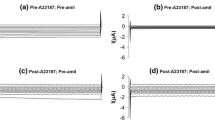Abstract.
We expressed the three subunits of the epithelial amiloride-sensitive Na+ channel (ENaC) from rat distal colon heterologously in oocytes of Xenopus laevis and analysed blocker-induced fluctuations in current using conventional dual-microelectrode voltage-clamp. To minimize Na+ accumulation we performed all experiments in low-Na+ solutions (15 mM). Noise analysis revealed that control or ENaC-injected oocytes did not exhibit spontaneous relaxation noise. However, in ENaC-expressing oocytes, amiloride induced a distinct Lorentzian component in the power density spectra. With three amiloride concentrations and a linear analysis of the respective changes in the corner frequency f c (2πf c plot) we determined the rate constants k on and k off for the amiloride-ENaC interaction. At a clamp potential (V m) of –60 mV k on was 80.8±5.1 µM–1 s–1 and k off 15.4±4.2 s–1. The half-maximal blocker concentration (K mic,ami) was 0.19 µM (V m=–60 mV). While k on was voltage-independent in the range –50 to –100 mV, k off and K mic,ami decreased significantly with increasing membrane hyperpolarization, resulting in an increased affinity of amiloride for its binding site on ENaC. Increasing extracellular [Na+] ([Na+]o) led to saturation of ENaC. Subsequent noise analysis revealed that single-channel current increased non-linearly with [Na+]o and that saturation was not due to a reduction in the number of open channels. The apparent affinity of Na+ for its binding site on the channel was voltage dependent and increased with hyperpolarization. Noise analysis revealed that k on and k off for amiloride decreased with increasing [Na+]o, while the affinity of the amiloride-binding site did not change. These findings show that the affinity of rat intestinal ENaC for amiloride is voltage dependent and is influenced non-competitively by [Na+]o, indicating that Na+ and amiloride do not compete for the same binding site at the channel.
Similar content being viewed by others
Author information
Authors and Affiliations
Additional information
Electronic Publication
Rights and permissions
About this article
Cite this article
Segal, A., Awayda, M.S., Eggermont, J. et al. Influence of voltage and extracellular Na+ on amiloride block and transport kinetics of rat epithelial Na+ channel expressed in Xenopus oocytes. Pflügers Arch - Eur J Physiol 443, 882–891 (2002). https://doi.org/10.1007/s00424-001-0773-x
Received:
Revised:
Accepted:
Issue Date:
DOI: https://doi.org/10.1007/s00424-001-0773-x




